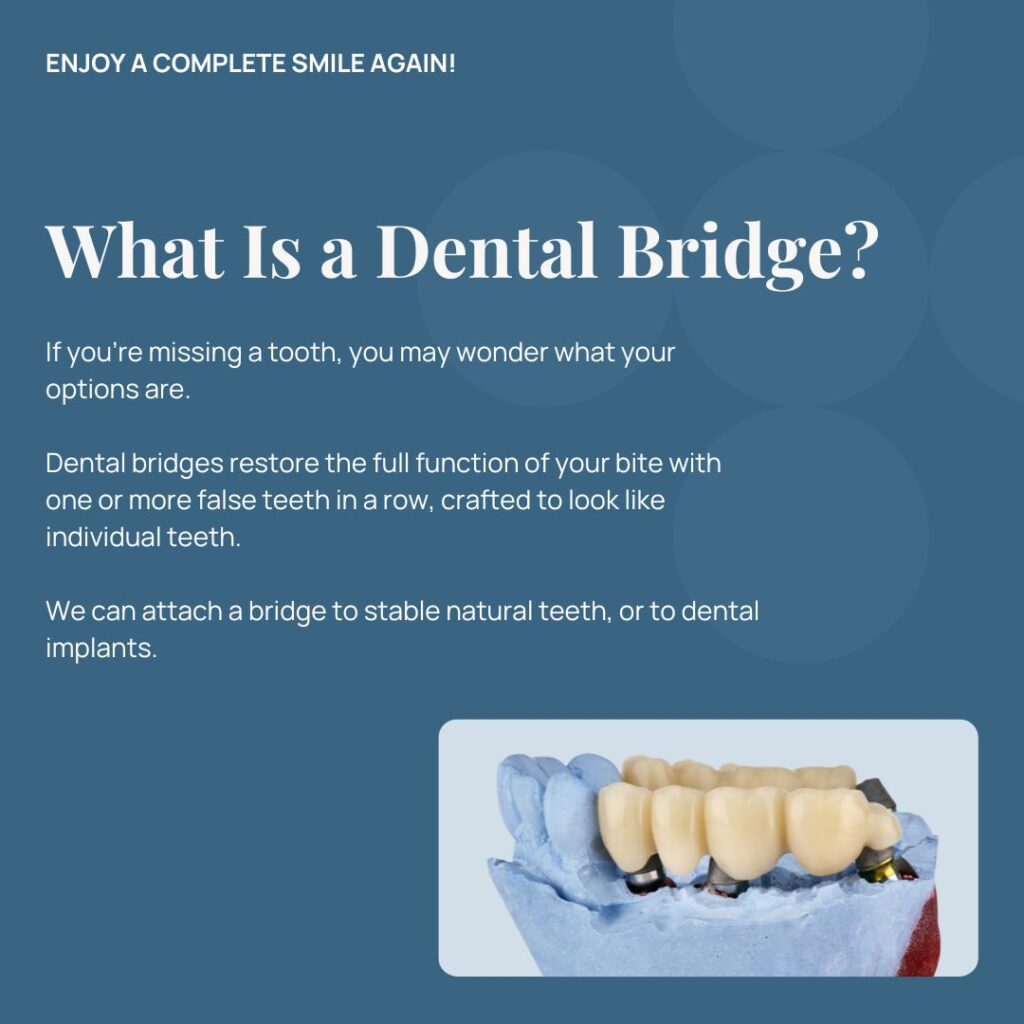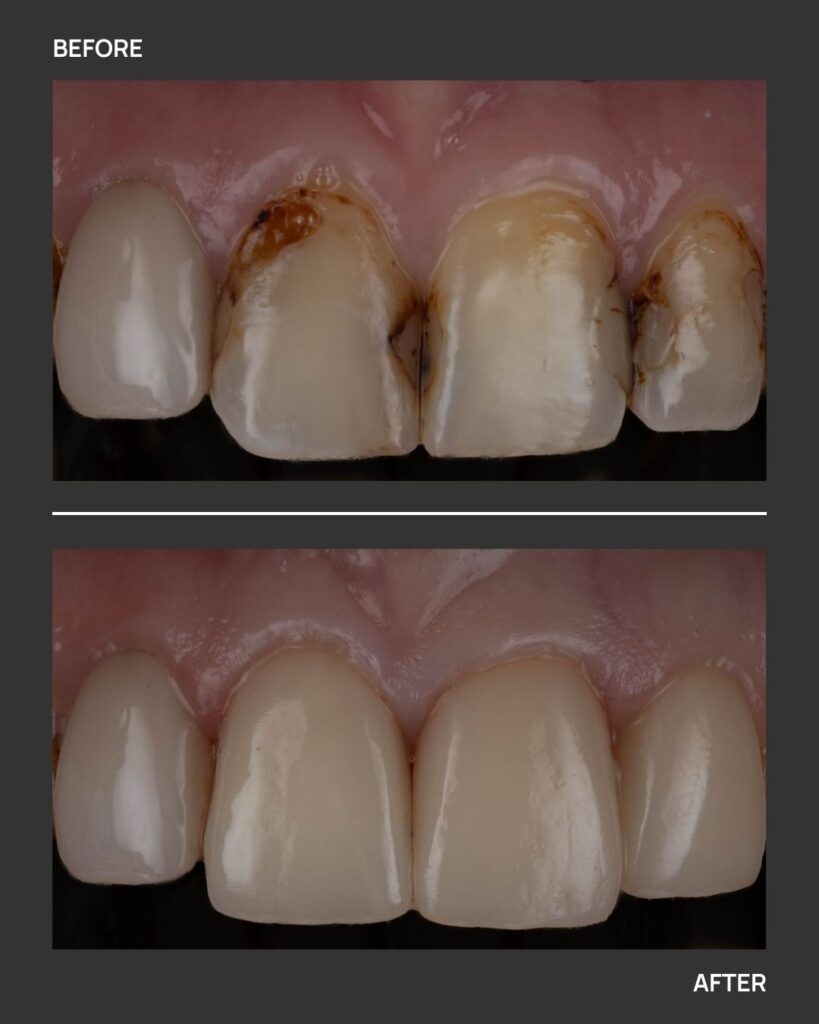When it comes to restoring damaged or missing teeth, you might hear the terms dental crowns and dental bridges used together. These treatments are often discussed in the same breath because they’re both used to repair and replace teeth, but they serve slightly different purposes.
So, how are they related, and what makes them different? Let’s dive into the details of crowns and bridges to help you understand which option might be right for your smile.
What Is a Dental Crown?
A dental crown is a tooth-shaped “cap” that’s placed over a damaged tooth to restore its shape, size, strength, and appearance. We frequently recommend a crown when a tooth has been significantly weakened by decay, a large filling, or a fracture. They’re also commonly placed after a root canal to protect the tooth and prevent further damage.
Crowns can be made from different materials, including porcelain, ceramic, metal, or a combination of materials. The goal is to create a durable covering that rebuilds the ideal shape and function of a tooth.
For crowns on front teeth, we’ll use ceramic materials that blend in naturally with the rest of your teeth. Once in place, a crown fully encases the visible part of your tooth above the gumline, providing support and protection.
What Is a Dental Bridge?
A dental bridge is a restoration that replaces one or more missing teeth. Unlike a crown, which covers a damaged tooth, a bridge is designed to fill the gap created by missing teeth.
It’s called a “bridge” because it literally bridges the space between your remaining teeth. A bridge typically consists of two or more crowns that cover natural teeth on either side of the gap, with an artificial tooth (or teeth) in the middle to fill the space.
Bridges are usually made from materials like porcelain or ceramic to mimic the look of natural teeth. They not only restore the appearance of your smile but also help with chewing and speaking, both of which can be affected when teeth are missing.

How Are Dental Crowns and Bridges Related?
Dental crowns and bridges are closely related because they often work together to restore your smile. In many cases, crowns are used to anchor the bridge in place, securing it to the teeth or implants on either side of a gap left by missing teeth. So, if you need a bridge to replace a missing tooth, you’ll often have crowns placed on the teeth next to the gap to support the bridge.
The process of getting a crown and a bridge is quite similar. For both treatments, your dentist will prepare the supporting teeth by reshaping them so that the crown or bridge can fit snugly. Then we’ll take impressions of your teeth to create custom restorations that match the shape and color of your natural teeth. Once your crown or bridge is ready, we will cement it in place, restoring both the function and appearance of your smile.
The main difference lies in their purpose: a crown is used to cover a single tooth, while a bridge spans the space of one or more missing teeth. Both solutions can significantly improve your oral health, and the decision between the two depends on your specific needs.
How Do Dental Implants Change the Use of Crowns and Bridges?
With advancements in dental technology, dental implants have changed the way we approach crowns and bridges. An implant is a titanium post that’s surgically placed in your jawbone to replace a missing tooth root.
Once the implant has fused with your bone (a process called osseointegration), a crown or bridge can be attached to the implant, offering a strong, long-lasting replacement for missing teeth.
Here’s how dental implants change the use of crowns and bridges:
- Single Implant with a Crown: If you’re missing one tooth, you might opt for a single dental implant topped with a crown. In this case, the crown replaces the missing tooth, and the implant acts as an artificial root. This solution doesn’t require altering your neighboring teeth, which is a key advantage over a traditional bridge.
- Implant-Supported Bridge: If you’re missing multiple teeth, an implant-supported bridge might be the best option. Instead of relying on your natural teeth for support, this type of bridge is anchored to dental implants. For example, if you’re missing three teeth in a row, your dentist might place two implants—one on either end of the gap—and use them to support a three-unit bridge.
This approach can provide greater stability and durability compared to traditional bridges. Full mouth dental implants are a type of extended bridge.
Pros and Cons of Each Option:
- Dental Implants: One of the biggest advantages of dental implants is that they prevent bone loss in the jaw, which can occur when teeth are missing. Implants are incredibly durable and can last a lifetime with proper care.
However, the process is more involved and requires surgery, which may not be suitable for everyone. Implants also tend to be more expensive than bridges or crowns alone. - Traditional Bridges: A traditional bridge is a faster and less invasive solution than implants. It doesn’t require surgery, and the process of getting a bridge can be completed in just a few appointments.
However, bridges do require altering the adjacent teeth, which can put them at risk for other issues later on. Additionally, while bridges can last a long time, they don’t have the same longevity or bone-preserving benefits as implants.

How Can Crowns, Bridges, and Dental Implants Improve Your Smile and Oral Health?
Crowns, bridges, and dental implants offer several benefits that go beyond simply improving the appearance of your smile. Here are some ways these treatments can enhance your oral health:
- Restore Function: Missing or damaged teeth can make it difficult to chew, speak, or bite properly. Crowns and bridges restore the function of your teeth, allowing you to eat and speak comfortably.
- Prevent Shifting Teeth: When a tooth is missing, the surrounding teeth may shift out of place, leading to misalignment. Replacing missing teeth with a bridge or implant helps keep your remaining teeth in their proper positions.
- Protect Weak Teeth: If a tooth is severely decayed or fractured, a crown can provide much-needed protection and prevent further damage. Crowns can also strengthen teeth after root canal treatment.
- Preserve Bone Health: Dental implants are unique in that they stimulate the jawbone, preventing bone loss that can occur when teeth are missing. This helps maintain the structure of your face and prevents the sunken appearance that can result from tooth loss.
- Boost Your Confidence: Whether you choose a crown, bridge, or implant, restoring your smile can give you a major confidence boost. You’ll feel more comfortable smiling, speaking, and eating in social situations.


